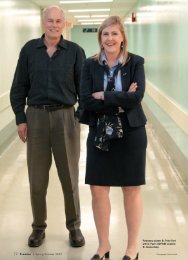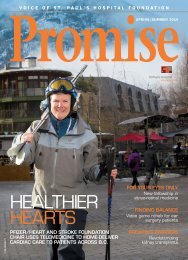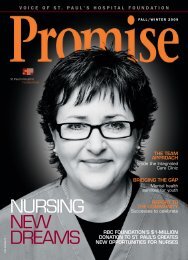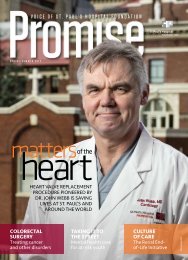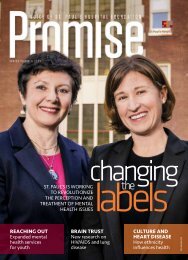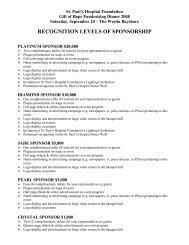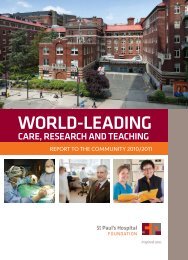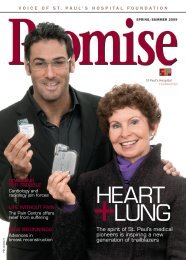TECK EMERGENCY CENTRE - St. Paul's Hospital Foundation
TECK EMERGENCY CENTRE - St. Paul's Hospital Foundation
TECK EMERGENCY CENTRE - St. Paul's Hospital Foundation
You also want an ePaper? Increase the reach of your titles
YUMPU automatically turns print PDFs into web optimized ePapers that Google loves.
<strong>TECK</strong> <strong>EMERGENCY</strong><br />
<strong>CENTRE</strong><br />
ST. PAUL’S HOSPITAL SETS A NEW BENCHMARK<br />
FOR <strong>EMERGENCY</strong> CARE WITH A RECENTLY<br />
COMPLETED RENOVATION.<br />
Clockwise from above: (left to right) Dr. Eric Grafstein (also below right), head<br />
of emergency services for Providence Health Care (PHC); Terry Selzler, project<br />
coordinator at Teck; Don Lindsay, president and CEO of Teck; Kevin Falcon, then<br />
Minister of Health Services; Dianne Doyle, president and CEO of PHC; and <strong>St</strong>ephen<br />
Shapiro, president and CEO of <strong>St</strong>. Paul’s <strong>Hospital</strong> <strong>Foundation</strong> unveil the new Teck<br />
Emergency Centre (here and below); (right) the renovation reduced wait times for<br />
patients and created a more efficient and effective work environment.
y yolanda brooks<br />
photography brian smith<br />
Life in a typical emergency department can often mean long<br />
periods of waiting and stress, punctuated by moments of high<br />
drama. Thanks to a $14.7-million renovation, <strong>St</strong>. Paul’s <strong>Hospital</strong>’s<br />
newly named Teck Emergency Centre is anything but typical.<br />
When you first enter the rejuvenated<br />
department, you quickly note the bright, clean,<br />
smart surroundings. However, the department<br />
has undergone more than just a superficial<br />
makeover. With more space, an improved layout,<br />
and new practices and technology systems<br />
in place, the Teck Emergency Centre is setting<br />
the pace for emergency medicine in hospitals<br />
across Canada.<br />
When Dr. Eric Grafstein arrived at <strong>St</strong>. Paul’s<br />
emergency department in 1993, the facility<br />
was definitely showing its age.<br />
“The biggest problem was that we had<br />
outgrown the space,” explains Grafstein,<br />
head of emergency services for Providence<br />
Health Care, which operates <strong>St</strong>. Paul’s. “At the<br />
time I started working at <strong>St</strong>. Paul’s, we were<br />
seeing about 40,000 patients a year. Our volume<br />
has grown by more than 50 per cent, to<br />
67,000 patients, so there really was no place<br />
to put patients.”<br />
Despite the conditions, <strong>St</strong>. Paul’s staff and<br />
physicians were up for the challenge, says<br />
Andrew Saxton Sr. A noted philanthropist<br />
and founder of the Grouse Mountain Skyride,<br />
Saxton was sent to the emergency department<br />
after his family physician grew concerned<br />
about his fluctuating prostate-specific antigen<br />
levels; Saxton credits his physician and<br />
<strong>St</strong>. Paul’s with detecting his prostate cancer<br />
early enough to be treated and was inspired to<br />
make a donation to the renovation project.<br />
“On more than one occasion, I had to show<br />
up with some very bad pain at the emergency<br />
department,” says Saxton. “The first person I<br />
saw was so compassionate that by the time I<br />
was signed up and sent to lie down, half my<br />
pain was already gone just because of the<br />
warmth and compassion that the people at<br />
every level there had shown.”<br />
21ST-CENTURY UPGRADE<br />
While emergency medicine has always been<br />
well equipped to deal with patients with critical<br />
injuries, patients with serious but non-lifethreatening<br />
injuries and the walking wounded<br />
were often less well served by one-size-fits-all<br />
emergency departments. <strong>Hospital</strong> administrators<br />
at <strong>St</strong>. Paul’s, together with emergency<br />
physicians and architects, spent many months<br />
working to develop an emergency department<br />
that could meet the changing demands<br />
of the new millennium.<br />
The renovated space features a new rapid<br />
assessment zone and groundbreaking diagnostic<br />
and treatment area. In addition, the<br />
acute resuscitation space, which serves the<br />
needs of the most seriously ill patients, is now<br />
double its former size.<br />
The four-bed rapid assessment zone is<br />
ideal for patients with serious but stable illnesses<br />
who need treatment quickly, but don’t<br />
require long stays or a full battery of tests.<br />
They are usually in and out of the department<br />
within a couple of hours, freeing up beds<br />
quickly and shortening wait times.<br />
The 24-hour diagnostic and treatment<br />
unit allows for aggressive monitoring and<br />
treatment of conditions that in the past led<br />
to hospital admission. The unit, which is<br />
overseen by an emergency nurse and nurse<br />
practitioner, serves patients who initially<br />
are too sick to go home; many of them often<br />
become well enough to go home within<br />
24 hours.<br />
With these units up and running, the<br />
emergency department not only provides<br />
a more responsive service for patients, it<br />
reduces the demand for in-patient space,<br />
which Grafstein calls “the most precious<br />
space in the hospital.”<br />
New technology plays a huge role in<br />
improving the patient experience. Bedside<br />
computers allow direct access to electronic<br />
patient records, while electronic tracking<br />
boards (similar to the arrival and departure<br />
boards at airports) allow staff to keep tabs<br />
on patients’ whereabouts, status and treatment<br />
times.<br />
Other upgrades include a new triage and<br />
admitting area as well as the streamlining of<br />
the triage and registration process, which<br />
now takes five to 10 minutes, instead of 15 to<br />
20 minutes. To enhance safety and security,<br />
the space has separate entrances for the public<br />
and for patients arriving via ambulance.<br />
Since the renovations began in October<br />
2007, patient wait times have dropped by an<br />
impressive 20 per cent. Positive feedback from<br />
patients and staff further demonstrate how<br />
the changes are being felt on the ground.<br />
“It has become a more pleasant place to<br />
work, and it seems to me it is a lot easier to<br />
recruit and retain staff,” observes Grafstein. “I<br />
think it is a place that everybody takes pride<br />
working in, and I think that is important.”<br />
The results are so impressive that emergency<br />
departments in hospitals throughout<br />
B.C., Alberta and Saskatchewan are looking<br />
to reduce wait times by implementing strategies<br />
similar to those at <strong>St</strong>. Paul’s.<br />
LEADING THE CHANGE<br />
The Vancouver-based mining company, Teck<br />
Resources, completed the funding of the renovation<br />
with a $2.5-million gift, part of which<br />
will be used to create the Teck Emergency<br />
Centre Innovation Fund to support research,<br />
academic productivity and the development<br />
of best practices at the hospital. In addition to<br />
Teck’s gift – the single largest corporate and<br />
capital donation in <strong>St</strong>. Paul’s history – the<br />
Province of British Columbia, through Vancouver<br />
Coastal Health, provided $10 million<br />
in funding support and 1,200 individuals and<br />
corporate donors combined to give more<br />
than $2.4 million.<br />
“We are grateful to Teck for stepping forward<br />
with this transformational gift to our<br />
emergency department, which is one of the<br />
busiest in the province and now one of the<br />
most technologically advanced in the country,”<br />
says <strong>St</strong>ephen Shapiro, president and CEO<br />
of <strong>St</strong>. Paul’s <strong>Hospital</strong> <strong>Foundation</strong>. “Their generosity,<br />
and the generosity of our other donors,<br />
is a signal to the community that <strong>St</strong>. Paul’s has<br />
a bright future ahead of it.”<br />
Supporting the renovation, which will<br />
benefit residents from across B.C., reflects<br />
Teck’s commitment to health and safety.<br />
“<strong>St</strong>. Paul’s has created a new facility that<br />
will enable its team of professionals to help<br />
more people, save more lives and put more<br />
people on the road to recovery,” says Don<br />
Lindsay, president and CEO of Teck. “There<br />
is no doubt that <strong>St</strong>. Paul’s <strong>Hospital</strong> is a valuable<br />
resource for the residents of Vancouver<br />
and the rest of B.C., and I am pleased that<br />
Teck has helped to make this a reality.” ■<br />
Spring/Summer 2011 • Promise 9





